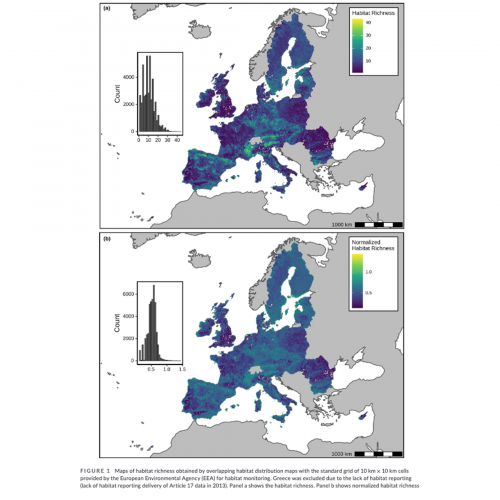When we talk about habitat richness, what variables affect the diversity of ecosystem types and which of those is most important? How do interactions among these variables influence habitat richness? An article titled “Diversity of European habitat types is correlated with geography more than climate and human pressure” was published in the journal of Ecology and Evolution explores precisely such questions. Co-written by Dr Duccio Rocchini from the SHOWCASE team, the article explores the challenges to traditional conservation approaches of dynamic ecosystems caused by changing climates and increasing anthropogenic pressure.
The habitat (or ecosystem) approach for conservation has been highlighted by the International Union for Conservation of Nature (IUCN) as a necessary stepping stone for conservation. Habitat richness reflects the state of environmental conditions and can serve as an explanatory variable for modelling the distributions and abundances of species or communities.
Studies in the past have analysed the factors influencing the spatial variation in species richness, which is usually correlated with variables such as climate, latitude, topographic heterogeneity, and anthropogenic pressure. The standard hypothesis is that species richness in equal sized sample sites should increase with the total amount of habitat. In the same way, the number of species inhabiting a region correlates with the number of vegetation types. Despite this, the relative importance of habitat amount and its spatial configuration (e.g. fragmentation, connectivity, perimeter/area ratio) is still debatable.
The paper analyses 222 terrestrial habitat types, defined by the Natura 2000 network, to calculate habitat richness for a 10 km x 10 km grid map in EU countries. The researchers investigated how environmental variables affect habitat richness by using generalised linear models, generalised additive models, and boosted regression trees.
They found that the main factors associated with habitat richness are geographic variables, with negative relationships for both latitude and longitude and a positive relationship for terrain ruggedness. Bioclimatic variables such as annual mean temperature and annual precipitation that slightly increase habitat richness play a secondary role. Another finding is that anthropogenic variables such as increased landscape fragmentation and increased population density decrease habitat richness significantly.
Ultimately, the researchers’ analysis highlights the positive and monotonic relationship between habitat richness and the richness of species with conservation concern. The research shows that a high number of habitats support a high number of species and vice versa, which confirms that habitat diversity at continental scales can be used as a pragmatic proxy for species richness – a useful tool to assess the status of biodiversity conservation.
Photo: Мaps of habitat richness obtained by overlapping habitat distribution maps with the standard grid of 10 km × 10 km cells provided by the European Environmental Agency (EEA) for habitat monitoring. Greece was excluded due to the lack of habitat reporting (lack of habitat reporting delivery of Article 17 data in 2013). Panel a shows the habitat richness. Panel b shows normalised habitat richness.
